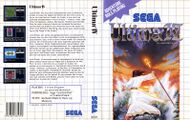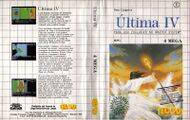Difference between revisions of "Ultima IV: Quest of the Avatar"
From Sega Retro
| Line 10: | Line 10: | ||
| genre=RPG | | genre=RPG | ||
| releases={{releases | | releases={{releases | ||
| − | | | + | | sms_date_uk=1990-12 |
| sms_rrp_uk=39.99 | | sms_rrp_uk=39.99 | ||
| + | | sms_date_fr=199x | ||
| + | | sms_date_de=199x | ||
| sms_code_eu=9501 | | sms_code_eu=9501 | ||
| sms_date_br=199x | | sms_date_br=199x | ||
| Line 22: | Line 24: | ||
The Master System version is very much like the Apple II original, however features updated graphics, music and gives its dungeons are played from top-down perspective (as opposed to the pseudo-3D first person view seen in the original). The NES version, released a year prior, makes more significant changes in terms of art design to appease a Japanese audience - the Master System version is hence seen as the more accurate of the two. | The Master System version is very much like the Apple II original, however features updated graphics, music and gives its dungeons are played from top-down perspective (as opposed to the pseudo-3D first person view seen in the original). The NES version, released a year prior, makes more significant changes in terms of art design to appease a Japanese audience - the Master System version is hence seen as the more accurate of the two. | ||
| − | Despite the game being created by an American company, the Master System version of ''Ultima IV'' was only released in Europe and Brazil. The direct sequel, ''Ultima V: Warriors of Destiny'' was released in 1988 and skipped Sega platforms, however at one stage the spin-off ''[[Ultima Underworld]]'' (which takes place after ''Ultima VI: The False Prophet'') was set to arrive on the [[Sega Mega CD]]. | + | Despite the game being created by an American company, the Master System version of ''Ultima IV'' was only released in Europe (in English, French and German variations) and Brazil. The direct sequel, ''Ultima V: Warriors of Destiny'' was released in 1988 and skipped Sega platforms, however at one stage the spin-off ''[[Ultima Underworld]]'' (which takes place after ''Ultima VI: The False Prophet'') was set to arrive on the [[Sega Mega CD]]. |
==Physical Scans== | ==Physical Scans== | ||
Revision as of 13:01, 5 August 2013
| Ultima IV: Quest of the Avatar | |||||
|---|---|---|---|---|---|
| System(s): Sega Master System | |||||
| Publisher: Sega | |||||
| Developer: Origin Systems Sega | |||||
| Genre: RPG | |||||
| Number of players: 1 | |||||
|
This short article is in need of work. You can help Sega Retro by adding to it.
Ultima IV: Quest of the Avatar, known as Última IV in Brazil, is an entry in the Ultima series of RPGs created by Richard Garriot at Origin Systems. It was originally released in 1985 for the Apple II computer, before being brought to the Sega Master System five years later in 1990 (the only Ultima game to be released on a Sega platform). Ultima IV is the first in the "Age of Enlightenment" trilogy, and though references Ultima III: Exodus and prior games, knowledge of previous adventures is not strictly necessary to understand Ultima IV.
Ultima IV is unusual as unlike other games in the series, there is not a defined end boss, or overarching villian in which the player needs to defeat. Instead, the player goes on a spiritual quest as "The Avatar" under instructions of Lord British (a.k.a. Garriot) to promote his eight virtues; honesty, compassion, valor, justice, sacrifice, honor, spirituality and humility, becoming a better person in the process and inspring the people of Britannia.
The Master System version is very much like the Apple II original, however features updated graphics, music and gives its dungeons are played from top-down perspective (as opposed to the pseudo-3D first person view seen in the original). The NES version, released a year prior, makes more significant changes in terms of art design to appease a Japanese audience - the Master System version is hence seen as the more accurate of the two.
Despite the game being created by an American company, the Master System version of Ultima IV was only released in Europe (in English, French and German variations) and Brazil. The direct sequel, Ultima V: Warriors of Destiny was released in 1988 and skipped Sega platforms, however at one stage the spin-off Ultima Underworld (which takes place after Ultima VI: The False Prophet) was set to arrive on the Sega Mega CD.
Physical Scans
| Sega Retro Average | ||||||||||||||||||||||||||||||||||||||||||||||||||||||||||||||||||||||||||||||||||||||||||||||||||||||||
|---|---|---|---|---|---|---|---|---|---|---|---|---|---|---|---|---|---|---|---|---|---|---|---|---|---|---|---|---|---|---|---|---|---|---|---|---|---|---|---|---|---|---|---|---|---|---|---|---|---|---|---|---|---|---|---|---|---|---|---|---|---|---|---|---|---|---|---|---|---|---|---|---|---|---|---|---|---|---|---|---|---|---|---|---|---|---|---|---|---|---|---|---|---|---|---|---|---|---|---|---|---|---|---|---|
|
| 85 | |
|---|---|
| Based on 20 reviews | |
- ↑ 1700 igr dlya Sega, "" (RU; 2001-xx-xx), page 244
- ↑ 1700 igr dlya Sega, "" (RU; 2001-xx-xx), page 323
- ↑ ACE, "August 1990" (UK; 1990-07-xx), page 61
- ↑ Aktueller Software Markt, "August/September 1990" (DE; 1990-07-27), page 64
- ↑ Complete Guide to Consoles, "Volume IV" (UK; 1990-11-xx), page 109
- ↑ The Complete Guide to Sega, "" (UK; 1991-05-xx), page 62
- ↑ Console XS, "June/July 1992" (UK; 1992-04-23), page 146
- ↑ Computer & Video Games, "August 1990" (UK; 1990-07-16), page 88
- ↑ Electronic Gaming Monthly, "March 1990" (US; 1990-xx-xx), page 18
- ↑ Game Mania, "May 1993" (UK; 1993-xx-xx), page 81
- ↑ Joystick, "Novembre 1990" (FR; 1990-1x-xx), page 107
- ↑ Mean Machines Sega, "October 1992" (UK; 1992-09-xx), page 136
- ↑ Player One, "Décembre 1990" (FR; 1990-xx-xx), page 32
- ↑ Power Play, "8/90" (DE; 1990-07-13), page 126
- ↑ S: The Sega Magazine, "August 1990" (UK; 1990-07-05), page 8
- ↑ Sega Power, "October 1991" (UK; 1991-09-05), page 60
- ↑ Sega Power, "December 1991" (UK; 1991-10-30), page 47
- ↑ Sega Pro, "April 1992" (UK; 1992-03-19), page 30
- ↑ Sega Pro, "April 1993" (UK; 1993-03-11), page 72
- ↑ Tilt, "Décembre 1991" (FR; 1991-1x-xx), page 52


